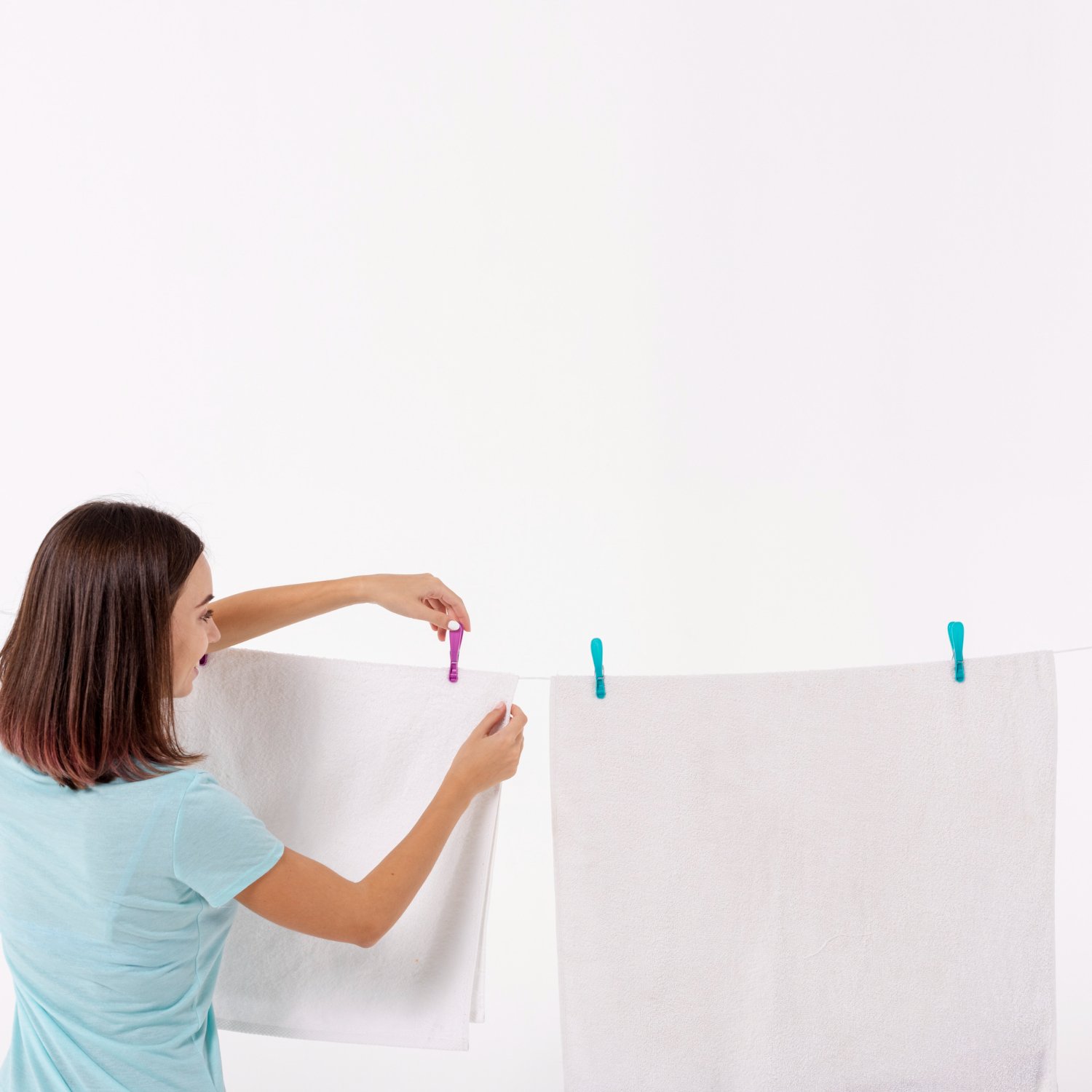Introduction
How to dry clothes without dryer: Whether you’re trying to reduce energy costs, prevent wear and tear on your clothes, or just don’t have access to a dryer, knowing how to dry clothes without one is a useful skill. It may also be a sustainable method of lowering your carbon footprint. This tutorial will cover a number of efficient ways to dry clothes without a dryer, speed-up techniques, and ways to preserve the quality of your clothing while doing so.
Why Dry Clothes Without a Dryer?
People choose to dry their clothes without a dryer for a variety of reasons. Among these are the following:
Benefits of Air Drying
Preserves Clothes’ Longevity: Dryers can cause fabrics to shrink, fade, or break down over time. Air drying helps maintain the integrity of your clothes by minimizing stress on the fabric.
Energy Savings: By not using a dryer, you’re reducing your energy consumption, which can significantly lower your electricity bill.
Gentler on Fabrics: Fabrics such as wool, silk, and delicate cotton often get damaged in dryers. Air drying ensures these delicate fabrics maintain their texture and quality.
Eco-Friendly Aspects
Reducing Carbon Footprint: Clothes dryers use a lot of electricity. Air drying helps reduce greenhouse gas emissions by eliminating the need for electricity.
Sustainable Living: Adopting air drying as part of your routine promotes sustainable practices and aligns with eco-conscious living.
Essential Tools for Drying Clothes Without a Dryer
How to dry clothes without dryer: There are a few basic items that can help you dry clothes more quickly and easily if you don’t have a dryer.
Clotheslines
A classic and effective method, clotheslines can be set up outdoors or indoors and are ideal for drying large loads of laundry. Make sure to install the clothesline in an area that gets plenty of sun and air.
Drying Racks
If you don’t have room for a clothesline, drying racks are a fantastic indoor alternative. They are portable, lightweight, and have a huge laundry capacity.
Hangers
One way to save space is to air dry your items on hooks. Just put dresses, shirts, and pants on racks and put them somewhere that gets plenty of air.
Towels
Towels can be useful when drying heavier fabrics. By laying a towel flat, you can place heavier garments on top to absorb excess moisture.
Methods for Drying Clothes Without a Dryer
Depending on the fabric type and your living situation, there are a variety of techniques to dry clothes without a dryer, each with unique benefits.
Air Drying Indoors
Drying clothing indoors is a useful option if you lack access to an outside area. Use hangers or a drying rack, and put them in a room with good ventilation. To help with drying, open windows and allow natural air to flow.
Air Drying Outdoors
For those with outdoor space, drying clothes outside is one of the best methods. Sunlight not only helps dry clothes faster but also naturally bleaches and sanitizes them. Be sure to check the weather before hanging clothes outside to avoid sudden rainstorms.
Using a Fan
By moving air around your clothing, a fan helps hasten the drying process. Put the fan on medium or high and place the clothing in the room. This technique is particularly helpful on rainy days when drying items indoors.
Towel Drying Method
Towel drying works well on bulkier materials like towels and sweaters. Lay the damp clothing on a clean, dry towel on a level surface, then wrap the towel up with the garment inside. Press gently to absorb extra moisture.
Ironing with a Cloth
This method combines ironing and air drying. Place a thin, clean cloth over the wet garment and gently iron it on a low heat setting. The heat from the iron will help remove moisture without damaging delicate fabrics.
Best Practices for Drying Clothes Indoors
How to dry clothes without dryer: When drying clothes indoors, certain practices can help ensure faster drying times and prevent issues such as mold or mildew.
Maximizing Air Circulation
Proper air circulation is key to drying clothes indoors. Open windows, use fans, or position your drying rack in a drafty area of the home to increase airflow. The better the air circulation, the quicker your clothes will dry.
Avoiding Humidity Issues
Clothes drying indoors in a humid setting can produce a wet atmosphere and slow down the drying process. Use a dehumidifier or open windows to let damp air out to reduce humidity.
How to Speed Up the Drying Process
There are occasions when you need your clothes to dry quickly. Here are some tips for accelerating drying without a dryer.
Using a Dehumidifier
By lowering atmospheric moisture, a dehumidifier facilitates the drying of damp clothing. In humid locations where clothes take longer to dry, this equipment works particularly well.
Placing Clothes Near a Heat Source
Clothes can be dried more quickly in cold weather by being placed close to a heat source, like a heater or radiator. Because too much heat can harm sensitive fabrics, take care not to put them too close together.
Utilizing a Hair Dryer
A hair dryer is a great tool for smaller garments. To prevent fabric damage, put the dryer to a cool or low heat setting and blow dry the garments while keeping the dryer at a safe distance.
Outdoor Clothes Drying Tips
One of the best methods for rapidly and naturally drying clothes is to do it outside. Here are some pointers for making the most of it.
Maximizing Sun Exposure
Sunlight is a natural disinfectant and helps clothes dry faster. To maximize exposure, rotate your clothes halfway through the drying process, ensuring both sides get ample sun.
Protecting Clothes from the Elements
While outdoor drying is great, unexpected weather can spoil the process. Keep an eye on the forecast and, if necessary, use a covered drying area to protect clothes from rain.
How to Dry Delicate Clothes Without a Dryer
How to dry clothes without dryer: Some clothes require extra care during the drying process. Here’s how to properly handle delicate garments.
Laying Clothes Flat
Delicate items such as sweaters or silk should be laid flat on a drying rack or towel. This helps prevent stretching and maintains the shape of the garment.
Using Mesh Drying Racks
A mesh drying rack allows air to circulate from all sides, making it ideal for drying delicate fabrics. It’s particularly useful for lace, wool, or knitwear that can be easily damaged if hung up.
How Long Does It Take to Dry Clothes Without a Dryer?
A number of variables, such as the fabric type, the weather, and the drying technique, affect how long it takes to dry garments without a dryer. Generally speaking:
Light fabrics such as cotton shirts can take 2-4 hours in sunny, windy conditions.
Heavy fabrics like jeans or towels may take up to 12 hours or more, depending on humidity and airflow.
Indoor drying can take 6-24 hours depending on ventilation and whether you use a fan.
Common Mistakes to Avoid When Air Drying Clothes
Avoid these typical blunders to guarantee that your clothing dries correctly and undamaged:
Hanging clothes too closely together: Without proper airflow, clothes will take longer to dry and may develop a musty smell.
Drying clothes in a humid area: High humidity slows down the drying process and can cause clothes to smell damp.
Leaving clothes in direct sun for too long: While sun helps dry clothes quickly, prolonged exposure can cause fading and damage to delicate fabrics.
Conclusion
How to dry clothes without dryer? An eco-friendly, economical, and fabric-friendly substitute is drying clothing without a dryer.This information appears overly automated. By using the appropriate methods and equipment, you can guarantee that your clothing dries effectively without sacrificing quality. The techniques in this article will help you become an expert at drying clothes naturally, whether you’re using a fan, air drying indoors, or taking advantage of sunny weather.
Frequently Asked Questions
Q:1 Can I dry clothes indoors without a drying rack?
A:1 Yes, you can hang clothes on hangers, use a shower rod, or lay them flat on a clean surface.
Q:2 Is air drying clothes better than using a dryer?
A:2 Air drying is gentler on clothes, more eco-friendly, and can save you money on energy bills.
Q:3 How can I prevent my clothes from becoming stiff after air drying?
A:3 Shaking out clothes before hanging them and using fabric softener during the wash can help prevent stiffness.
Q:4 Will clothes dry faster if I hang them in the sun?
A:4 Yes, sunlight not only helps clothes dry faster but also sanitizes them naturally.
Q:5 Can I use a fan to dry clothes indoors?
A:5 Yes, a fan can increase air circulation and help clothes dry faster indoors.
See More



